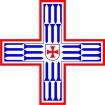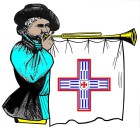ADOPTED HYMNS AND FLAG OF THE ORDER
During International Events wherein the Order is officially represented, the Ceremony Master and/or the Protocol Officer of the host Order will present the Honour to our Order by playing its Hymn and its Entry March. These will be played for our Ordre´s Grand Master or its Ambassador (and for its Grand Prior, in the absence of the aforesaid), preceded by the State Flag of our Order.
During National Events (in Germany and Belgium) the Grand Master of our Order may be preceded by Scottish Pipers. The Flag will be one of the Ordo Balliolensis.
According to the History of the Ordo Balliolensis, the Magisterial Convent decided to use for the musical environment.
:
MUSICAL ENVIONMENT
The Hymn of the Ordo Balliolensis is a musical aria from the Renaissance. It was composed by the Flemish musician Pierre Phalèse (1510-1575). The Hymn was played officially and for the first time on September 6, 2014, in Bucharest, during the Investiture Ceremony for the 10th anniversary of the Grand Priory of Romania.
The Trumpet or Bugle Call (sonnerie) is by the Italian composer Antonio Salieri and is entitled "Imperial Fanfare". It can be replaced by the Bugle Call "stipendium operam" or "pay attention" composed by Mgr. Fra. Robert Adelsohn Bels. It is a Ringtone for Trumpets in C-dur (time: 0'30).
The Entry March (for the Grand Master) is a work of Scottish Music played by Bagpipes.
In the absence of Bagpipes or if decided so, an Entry March (for the Grand Master) can be played by the Organ and Timpani. It is the short March "Barnard Castle" composed in C-dur (Time 1'00), by Mgr. Fra. Robert Adelsohn Bels.
The March of Entries and Exits (for the Assembly) is a majestic march "Hymn" composed in C-dur for Organ and Timpani, by Mgr. Fra. Robert Adelsohn Bels. The first public performance was played (without Timpani) at the Ludwigslust Investiture on 18 May 2019. (Time: 3'50).
The Rallying Cry of the Order is "Balliol"! It is the cry that unites all the vassals ! Today obsolete, it retains its historical value. This cry is taken up again on the Pennon.
The Last Post is played during the Investitures at the moment of the Minute of Silence for the deceased of our lineages. It is played after the lighting of the candles of Memory.
THE STATE FLAG
The State Flag of the Order which is one of the very early Counts of Flanders (Lydéric I van Buc). *abt 622 +676 or 692, Grand Forestier de Flandre, Count of Tournaisis (646), Count of Artois, in Lens, Leude and Lord of Thérouanne (649). Also called Lord of Harlebeke (Harlbeke). This Flag happened to be also the Flag of Westvlanderen (A Flemish State in Belgium).
The more recent Flag of the Counts of Flanders, taken by the Count Thierry d´Alsace (Black Lion, with red pawns and red tongue on a yellow background) and dating the XIIth century, had to be abandoned by the Ordo Balliolensis.
This is due to the historical fact that the Lineage of the BELS goes back to the very first Counts of Flanders and even four centuries before !
Above, the Flag taken over by State of West-Flanders (Belgium),
registered by decret dated 27th May 1997 and officially published in the
Belgian "Het Staatsblad" on 12th July 1997.
The Flag contains 6 blue (Azur) rays on a yellow (Or) background
centered by a red (Gueules) Escucheon.
Mathilde de Flandre (+1083), spouse of Wilhelm the Conqueror,
carried her ancestors` Flag but with only 4 blue (Azur) rays on a yellow (Or) background.
Consequently, the Ordo Balliolensis decided, upon the legal advice given by Fra.
Herbert Class, one of its Knights of Honour, dated Sterrebeek (Belgium) 12th June 2018, to take the Flag with 5 blue (Azur) rays (See below) on a yellow (Or) background, which is the one carried by all the old Counts of Flanders (by old we understand - before the Count Philippe d´Alsace (1170) - who decided to take the Black (Sable) rampant Lion with red (Geules) tongue and pawns on a Yellow (Or) background).
The Flag reminds us of the ties that have united us for more than 1377 years (2019-642) with Flanders and its Counts, installed first as Foresters, in the year 621, by the Merovingian King Dagobert I and confirmed in the year 862, in Tournai, by King Charles the Bald (Capetian).






